US & Japanese Broadcasters Both Try to Keep Their "Fingers in the Dike"
On Saturday the following tweet appeared from NAB Labs - “an initiative of the National Association of Broadcasters (NAB) to foster innovation and propel broadcast television and radio into the future.”

One immediate question is what really is NAB Labs? Earlier this year we speculated that “NAB Labs might appear possibly promising, but is most likely just a PR effort from a PR-focused trade association wanting the appearance of a counterpart to CableLabs.” Is NAL Labs an “initiative” or is it a technical facility? First we see that the address is the same as the NAB headquarters - near the former FCC location. Not exactly a technical hotbed area, although I miss all those nice restaurants. How big is NAB Labs? No budget information can be found. Their site gives 10 names, but policy wonk readers will recognize that several have NAB policy positions and are not primarily involved in R&D or testing.

By comparison, the similarly named CableLabs near Boulder CO has 175 employees in the building shown above. While it is unclear what the total size of the building is, it includes “over 12,000 square feet of lab space to suppliers and members who wish to use this development area.”
To give another example of how an industry develops a lab to support its members, consider the Electric Power Research Institute (EPRI), located in Palo Alto, CA - also more conducive to R&D than the Dupont Circle area. EPRI has 700 employees and an annual budget of nearly $400M. An inspection of their main office on Google Maps shows a complex with 8 buildings. So it would appear that both the CATV industry and electric power industry has “brick and mortar” labs, whereas “NAB Labs” is of a different genre.
But back to the original NAB Lab tweet. It dealt with the long standing FM in cellphone issue that has been a recurring topic here. This started as an attempt by NAB in 2009 to solve a totally unrelated copyright issue by agreeing with MusicFirst, a copyright holders group, to a package of terms that included joint lobbying for legislation to require FM receivers in all cellphones. While there has been no public discussion of such a legislative requirement recently, the new NAB Labs tweets signals something is warming up. The tweet has a link to a NAB Labs page entitled “FM Radio in Smartphones”.
NAB Labs has discovered data that
“indicates that essentially all of the 90 million smartphones sold in the U.S. during that period (2013) were equipped with an FM radio tuner, yet FM reception was activated for users in only about 4 percent of those phones. About 18 million of those phones (20 percent of the top sellers) have fully operative FM radios in their versions sold outside the U.S., indicating that FM reception could be easily activated by carriers in the U.S. versions, likely without changing the smartphone hardware.
Why does it matter? Americans are consuming more audio and video on the go than ever before. Smartphones and tablets have turned into walking entertainment centers. But the convenience of on-the-go entertainment can carry a hefty price tag as wireless companies charge by the bit. With FM radio capability, a mobile device user doesn't have to stream audio, but receives it over the air for free – with less battery drain on the device. And during crisis situations when cellular networks can go down, over-the-air radio stays on.”
Now if NAB is right, why doesn’t the marketplace work here? CTIA argues below that its does:
This continuing attempt by NAB to counteract marketplace forces sounded analogous to action by their Japanese counterparts a year ago. When faced with a new TV model with Internet capabilities that were threatening to their industry model. An English language peer in Japan reported
Panasonic says Japanese TV stations are refusing to air commercials for its new “smart” television, apparently because they feel threatened by its combined TV-Internet function.
Private broadcasters, in a rare case of turning down a major advertiser, have said they will not show commercials for the product, claiming the split screen simultaneously showing broadcast content and Web pages may confuse viewers, according to reports.
So it looks like Japanese broadcasters are also trying to put their finger in the dike to slow marketplace and new technology forces.
New Millimeter Wave Textbook Just in Time for 24+ GHz NOI
In some ways this book is reminiscent of the pioneering 1976 publication of Robert Dixon’s Spread Spectrum Systems with Commercial Applications. At the time Dixon’s book was published there were published articles on most aspects of spread spectrum/CDMA technology, but they were scattered other a lot of different journals, often with different jargon, nomenclatures, and symbology in equations. While Dixon had few equations, he tied all the concepts together in a single approachable book. Similarly, but at a higher technical level, this book ties together its subject matter in a consistent way from a variety of sources, although in this case the authors are themselves major pioneers themselves in this technology.
The title’s, Millimeter Wave Wireless Communications, use of the term “wireless” needs a little clarification. It is used primarily in the context of its use in “CTIA-The Wireless Association” - to mean what we spectrum policy wonks call CMRS - commercial mobile radio systems. More specifically it deals with base station/mobile uplinks and downlinks in the mmW region - something that was thought inconceivable a decade ago. However, it also deals with unlicensed 60 GHz systems such as those permitted under §15.255. It does not deal with fixed services such as the 70, 80, and 90 GHz systems authorized under §101.1501+ and does not deal with other radio services such as satellite systems, except in brief parenthetical sections. But within its scope it is very thorough and unique in its comprehensive treatment of this rapidly evolving technology. I would urge the authors to expand the scope to include fixed systems in the almost certain next edition since much of the present material already applies to both mobile and fixed.
Since this is a spectrum policy blog, let us mentioned a final concern: the discussion of the evolution of US mmW regulations has some minor garbles. For example on p. 507 it states that in 1998 “USA became the first country in the world to authorize low power unlicensed 60 GHz operations”, while 2 pages later it says “In 1995, the FCC allocated the 57-64 GHz frequency band for unlicensed communications” - which is the correct date although the initial band was 59-64 GHz. Readers wanting a more detailed and accurate history, including the key 1988 study from the UK spectrum regulator suggesting unlicensed in 60 GHz, might wish to read your blogger’s history page on the subject. However, most readers of the book will not be spectrum policy wonks and will probably glance over these details.
But the people who have to draft comments in Docket 14-177 and those who will be designing mmW mobile systems needs not be concerned about these points. Within its prime subject matter of CMRS uplinks/downlinks it ties together for the first time information in disparate issues such as
- multipath mobile mmW propagation,
- atmospheric effects
- antenna technology including adaptive antenna technology to overcome the multipath,
- mmW device technology, and
- high level design issues
Mysterious 10/24 "Special Commission Meeting"
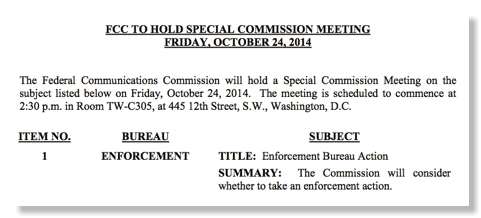
Late Friday FCC released a very unusual sunshine notice for a “special commission meeting” on 10/24 at 2:30 PM - itself an odd time for such a meeting. What is going on?
In response to our tweet on the issue several speculated it deals with the **dskins matter. We don’t think so. The issue there is a challenge to a broadcast station renewal which is not an enforcement matter and will be dealt with in a different procedure on a less urgent basis.
Our best guess is that this is something that has lingered on circulation at FCC for a while with a cryptic title that no one noticed since there are often such cryptic enforcement titles on the list. The Chairman has great control over the FCC’s agenda and perhaps got fed up with this issue lingering on the circulation list without everyone voting on it and perhaps forced the issue to a head by calling an open meeting when they can force a vote if a quorum shows up. This presumes that at least 2 other commissioners want the issue resolved in a public way.
What type of issue would force such a confrontation on the 8th Floor? Most likely it is an issue that will be of interest to consumers - considering how close it is to the election.
One possibility is a net neutrality-like issue with a major ISP. While FCC has no specific net neutrality rules in place, a case could be make that some major ISPs has been deceiving customers - a violation of other rules that are in place. For example, my ISP charges me for 15 Mbps service and advertises that it meets or exceeds that goal, but when I use Netflix I am certain that the speed is much less.
On the other hand Communications Daily reported today that it is a routine enforcement matter that was about to meet a statute of limitations deadline and that the 2 Republicans had not voted yet on it during circulation due to concerns about an overly aggressive stance of the new EB leadership. As we have written before, the basic problem in recent years has been that EB has been too enforcement adverse. Clearly there is a disagreement on this issue on the 8th Floor. Commissioners generally want to be friends with various industries. Giving out things like spectrum gets you friends, taking enforcement actions doesn’t.
UPDATE
Surprisingly FCC kept secret the details of who they target of this enforcement action was until about 2 hours before the scheduled “special meeting”. At that time a press released appears on the FCC website with the basic details and said a fine would be issued and the meeting was cancelled. Late in the day, an NAL was posted about “10M Fine Proposed Against TerraCom and YourTel for Privacy Breaches”. Note that Commissioners Pai and O’Rielly had serious questions about the statute involved and the lack of FCC rules and precedents in this area. We will leave it to the courts to decide who is right.
Do not expect your taxes to decrease because of the accused firms paying $10M. Your blogger doubts anywhere near that will ever be collected based on past experience. May there will be a consent decree, but it will likely be for much less.
Here is a story about it from our hometown newspaper entitled “FCC: Phone companies posted private info online” with additional information
Acceleration of Broadband Deployment by Improving Wireless Facilities Siting Policies
The discussed focused on the urgent need for wireless capacity and the related wireless infrastructure. WE FULLY AGREE!
But there were 2 key points that were not said, perhaps they would be awkward given the influence of the cellular establishment at FCC and in DC in general.
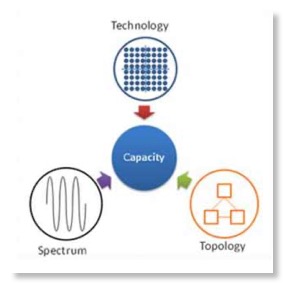
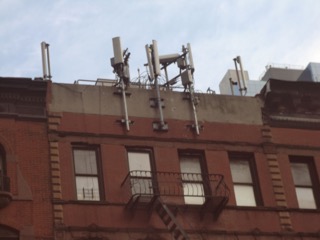
Now the cell industry does sometimes due a good job in designing infrastructure to match its environment. Here are 3 examples of apparently modest cost installations that are reasonable design compromises. Note that in all 3 cases the covers/radomes of the antennas approximately match the surface they are mounted on; in addition there a no loose visually contrasting cables in these last 3 photos:
(In NYC only 2 blocks from the previous photo)
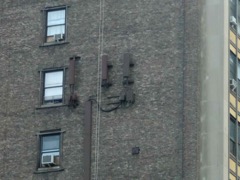
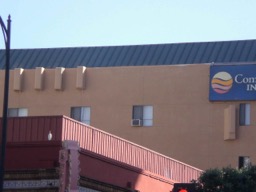
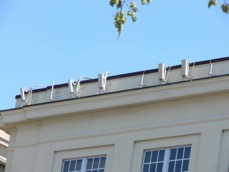

“All politics is local”
There is a limit how much the cellular industry can impose on local jurisdictions at the current ugliness levels without a grassroots political backlash. But well designed infrastructure need not be either ugly or very expensive. More consistent attention to physical design is urgently needed!
UPDATE
PCIA Press Release: PCIA Applauds FCC’s Order on Wireless Infrastructure – Streamlined Rules Will Speed Broadband Deployment
HBO & CBS: Enabling Cutting Both the CATV and Spectrum "Cord"

Even major NAB member CBS is jumping on the bandwagon of alternatives to spectrum! Today they announced CBS All Access:
“a new digital subscription video on demand and Nielsen-measured live streaming service for the CBS Television Network. CBS All Access will offer subscribers thousands of episodes from the current season, previous seasons and classic shows on demand, as well as the ability to stream local CBS Television stations live in 14 of the largest U.S. markets at launch”.
Since the end of WWII broadcast over-the-air (OTA) TV has been both a large spectrum user and a huge player in spectrum regulation. When I joined FCC in 1979, we were at the end of a spectrum policy era in which the TV broadcasters, Motorola, and AT&T were the key players and virtually dictated how spectrum would be divided between their constituencies. Now Motorola and AT&T are a shadow of their former selves and perhaps the time has come for the TV broadcasters to “exit left” from the spectrum policy dictating business.
Sources have told us that the early drafts of the National Broadband Plan pointed out that when 50+ Mbps broadband becomes a universal service-like national norm - something that is critical to US society and economy for reasons not directly related to spectrum policy, then spectrum for OTA TV in urban areas will no longer be important since the content can be easily distributed over the broadband. Now some will ask about the economically disadvantaged - a real concern. But is allocating 100s of MHz and pumping megawatts in the ether the only way to deal with universal access to “free TV”? Universal access could also be handled by providing Internet based distribution of “basic video” - the present “free TV” - on either a Universal Service Fund-like model or via a freemium pricing model where basic video is free over broadband and higher tier services are priced separately, either in packages or individually. You will not find any such discussion in the published NBP. It was too controversial and pressure from the Hill resulted in its deletion as a topic.
Recall the Justice Alito 2012 quote shown above in a dialogue with Fox’s lawyer at the Supreme Court. Elected officials, FCC staff, and even FCC commissioners can not be as candid as Justice Alito who has life tenure. Maybe OTA TV will be here forever, but shouldn’t FCC and the spectrum policy community consider other alternatives?
The spectrum held by TV broadcasters today has huge economic value. Without worrying about issues of “unjust enrichment” we should let the broadcasters recoup that market value by programs such as the incentive auction so that the spectrum goes to its best uses - not necessarily the CTIA membership. The present OTA broadcasters will thus be compensated and the political process will not have to deal with determining fair compensation or the nuances of § 304. But the main reason OTA broadcasters use spectrum and megawatts of RF is get “must carry” rights to demand compensation from MVPD operators. The vast majority of US household simply do not watch OTA signals directly, although NAB and CEA can’t agree on the details of the data. There must be a better way!
We also note that this year HBO and Game of Thrones dominated Emmy nominations. Here's how the broadcast networks stacked up:
- CBS – 47 nominations
- NBC – 46 nominations
- ABC – 37 nominations
- PBS – 34 nominations
- FOX – 18 nominations
And here's the list of non-OTA leaders
- HBO – 99 nominations
- FX Networks – 45 nominations
- Showtime – 24 nominations
- Comedy Central – 21 nominations
- Lifetime – 17 nominations
- FOX/NatGeo – 12 nominations
Notice a trend?
An Incorrect NerdAlert Prediction from 11/13
866 Mbps Achieved in Unlicensed 60 GHz Band
.Samsung Electronics announced the development of its 60GHz Wi-Fi technology that enables data transmission speeds of up to 4.6Gbps, or 575MB per second, a five-fold increase from 866Mbps, or 108MB per second, the maximum speed possible with existing consumer electronics devices. As a result, a 1GB movie will take less than three seconds to transfer between devices, while uncompressed high-definition videos can easily be streamed from mobile devices to TVs in real-time without any delay.
“Samsung has successfully overcome the barriers to the commercialization of 60GHz millimeter-wave band Wi-Fi technology, and looks forward to commercializing this breakthrough technology,” said Kim Chang Yong, Head of DMC R&D Center of Samsung Electronics. “New and innovative changes await Samsung’s next-generation devices, while new possibilities have been opened up for the future development of Wi-Fi technology.”
Unlike the existing 2.4GHz and 5GHz Wi-Fi technologies, Samsung’s 802.11ad standard 60GHz Wi-Fi technology maintains maximum speed by eliminating co-channel interference, regardless of the number of devices using the same network. By doing so, Samsung’s new technology removes the gap between theoretical and actual speeds, and exhibits actual speed that is more than 10 times faster than that of 2.4GHz and 5GHz Wi-Fi technologies.
Until now, there have been significant challenges in commercially adopting 60GHz Wi-Fi technology , as millimeter waves that travel by line-of-sight has weak penetration properties and is susceptible to path loss, resulting in poor signal and data performance. By leveraging millimeter-wave circuit design and high performance modem technologies and by developing wide-coverage beam-forming antenna, Samsung was able to successfully achieve the highest quality, commercially viable 60GHz Wi-Fi technology.
In addition, Samsung also enhanced the overall signal quality by developing the world’s first micro beam-forming control technology that optimizes the communications module in less than 1/3,000 seconds, in case of any changes in the communications environment. The company also developed the world’s first method that allows multiple devices to connect simultaneously to a network.
As is the case with the 2.4GHz and 5GHz spectrum, the 60GHz is an unlicensed band spectrum across the world, and commercialization is expected as early as next year. Samsung plans to apply this new technology to a wide range of products, including audio visual and medical devices, as well as telecommunications equipment. The technology will also be integral to developments relevant to the Samsung Smart Home and other initiatives related to the Internet of Things
Note the first sentence of the last paragraph: “As is the case with the 2.4GHz and 5GHz spectrum, the 60GHz is an unlicensed band spectrum across the world”. This did not happen by accident. It happened because of FCC initiatives in the 1980s and 90s that recognized technological advances had made new technology possible that was prohibited by anachronistic FCC rules at those times. The initiatives removed those prohibitions but did not require incumbent users to change their operations on bit nor did it increase their interference risk. As a result we have had technical innovation and economic economic growth.
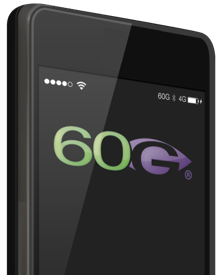
While other WiGig companies like Intel, Wilocity (now owned by Qualcomm) and Nitero have been developing super-fast radios that work 60GHz channel, Samsung claims they’ve actually produced these enhanced speeds by fixing interference issues caused by other devices on the channel.
Now the problem is that the new NOI is rumored to contain a discussion about possible partial or total repurposing of the 60 GHz band for cellular communications, presumably on a licensed basis. The question to be considered on the 8th Floor is how will the fording of the 60 GHz discussion impact capital formation for innovative unlicensed 60 GHz technologies. We are sure the 60 GHz companies have less visibility on the 8th Floor than the major CTIA members and their insatiable demand for spectrum.
We hope the 8th Floor considers carefully the wording of such discussion and its impact on capital formation for ongoing unlicensed 60 GHz systems.
So When are the Comments on this NPRM Due?

An interesting question heard both inside and outside FCC is “when are comments due to NPRM x?” When NPRMs and similar documents that result in comments are released they usually are written as shown above with a date relative to Federal Register (FR) publication. (The Net Neutrality NPRM was a notable exception and had a clear due date on the version released by FCC.) The reason for this relative date is due to uncertainty in FR publication date which can be large compared to the comment period in many proceedings. Your blogger believes that much of variable delays in FR publication is due to back office problems at FCC in work groups of career civil servants that have low visibility and low pay grades but perform key ministerial functions in the final release of FCC documents, oddly called the “BARF process”, and in the final formatting of the text for transmission to the folks at the FR. (When documents contain tables and other unusual formatting there are usually problems getting them in the specific forma acceptable to the FR. Incorporating nonfederal standard by reference, e.g. as in §15.31(a)(3), also adds uncertainty to the final approval process due to its complexity although it is generally desirable.)
So how do you find out when things are actually due? Large law firms have paralegals that scan the FR every day for FCC items and update internal data basis for their lawyers who then inform their clients. Important items make the news in expensive trade publications such as TR Daily. But what about the rest of us?
The bureaucratic answer is to search for the published items in either the FR site or the newer Regulations.gov, “Your Voice in Federal Decision-Making”.
(Regulations,gov is part the eRulemaking Program, established in October 200as a cross-agency E-Gov initiative under Section 206 of the 2002 E-Government Act (H.R. 2458/S. 803) and is based within the U.S. Environmental Protection Agency. The eRulemaking Management Office (PMO) leads the eRulemaking Program and is responsible for the development and implementation of the public facing website, Regulations.gov. FCC is not a “partner agency” in the eRulemaking Program because it required shared funding. FCC is classified as a “Nonparticipating Agencies” in the program and its is not fully integrated - again a nod to FCC’s perpetual budget problems. The Office of the Federal Register (OFR) of the National Archives and Records Administration (NARA), and the U.S. Government Printing Office (GPO) jointly administer the FederalRegister.gov website.)
While working at FCC, your blogger tried and experiment to address this issue. The attempt is shown below and actually still lingers with old data on the FCC’s vast disorganized website:
Circa 2006 Experiment in Making Docket Information More User Friendly (Click to expand size)
This table with its links to both EDOCS and ECFS as well as comment date data is one simple, user friendly way to present data. Note the “title” of each proceeding is not the official title on the caption of the coverage of the FCC document. The official caption is often a cumbersome name or one assigned early in the drafting process before the scope of the proceeding was firmly established. The tile is a plain English description of what the docket is actually about, like “net neutrality”.
So why can’t FCC give us a simple way to find to when comments are actually due in its proceedings?
Chmn. Wheeler, Tear Down This 95 GHz Wall!

On October 17, FCC will consider a millimeter wave (mmW) NOI that will be the first major mmW deliberation there in more than a decade. mmW is sometimes called the “spectrum frontier” and is the upper end of radio spectrum that is enabled by breakthrough technology. Indeed, a major motivation for the NOI is that the work of Ted Rappaport of NYU and others has shown that mobile use above 24 GHz is practical.
(Your blogger recalls that in the early 1980s when Motorola was pushing for more Part 90 sharing of UHF TV spectrum - an action that indirectly resulted in DTV due to an NAB backlash - Motorola and others claimed land mobile above 1 GHz was physically impossible!)
Description of 10/17 NOI from FCC Tentative Agenda
Due to military R&D, US firms are the leaders in basic mmW technology, but commercial mmW applications lag in part due to outdated FCC policies and the general procedure of FCC to wait for petitions its in inbox. Does FCC really think that it is easy to raise capital for moving technology from IEEE journals to the marketplace win part of the process is getting FCC to act on a rulemaking to permit the new technology? As part of my teaching last year, I asked 3 prominent communications attorneys in DC how long they thought it would take for FCC to act on approving a new technology using the verging spectrum above 95 GHz. The answers were all in the 3-5 year range!
This is not how we facilitate US technological competitiveness and economic growth. The roots of Wi-Fi and Bluetooth was a policy of FCC Chairman Ferris, later supported by Chairman Fowler, that FCC should identify promising technologies held back by anachronistic FCC policies and modify those policies to allow the technologies - with due deference to others who might be adversely affected - but not to require the new technologies. Indeed, Qualcomm cofounder Andrew Viterbi has said that the May 1985 FCC spread spectrum decision was important in enabling the final capital formation for the incorporation of Qualcomm 3 months later as it showed real FCC interest in CDMA which was then opposed by most mainstream industry players. (Cofounder Irwin Jacobs and the current Qualcomm management differ on this point and some others about the early company history.)

Now FCC has an analogous wall in spectrum policy at 95 GHz, depicted at the top of this post. While FCC (and ITU) has spectrum allocation up to 275 GHz, it has no unlicensed or licensed service rules above 95 GHz, a point reached in October 2003. At left is a Japanese 125 GHz system used at the 2008 Beijing Olympics in quantity for moving view from stadiums to the broadcast center. Use of similar technology is not permitted under current FCC Rules! So is it surprising that despite US leadership in millimeter wave components no such systems are being made in USA?

Above is a diagram of a German 237 GHz System exceeding 100 Gbits/s. Not only is its sale and use illegal in USA, but such an experiment probably could not have even been authorized due to the recent glitch in §5.85(a) that came about in the Report and Order of Docket 10-236 that for the first time forbids all experiments in passive bands. This change was made without any explanation and without any supporting comments. A timely filed Petition for Reconsideration on this issue has received no objections in more than a year and is supported by others, yet the matter is still unresolved at FCC. (Note, if FCC can not complete the whole reconsideration order on this docket in a timely way, it could at least issue a public notice announcing an interim liberal waiver policy for mmW experiments that impinge on passive bands based on whether there will actually be interference at the place and time of the experiment and NTIA - home of “spectrum sharing is the new normal” - could say that it supports such a policy as all such bands are G/NG shared.)
So here is what we urge FCC to do at the 10/17 meeting:
- Make clear in the NOI that the wall at 95 GHz is not intentional and is not a fundamental barrier to any proposed mmW uses.
- Make clear that despite theTentative Agenda description given above for the NOI that FCC is open to consider all uses of spectrum in the mmW bands, fixed, mobile and others and promises timely consideration of new proposals in order to support US competitiveness in mmW technology
FCC 10/17 NOI to Explore Cellular Use in 60 GHz Wi-Fi Band
In a 9/26 blog post Chmn. Wheeler wrote:
“Sustaining the mobile revolution also depends on our invisible infrastructure – spectrum. The fact that there is no low-hanging fruit in our spectrum inventory that can easily be repurposed for broadband means that the Commission needs to think creatively about how to make more spectrum available and increase the efficiency of its use.
Historically, mobile wireless services have been targeted at bands below 3 GHz due to technological and practical limitations. However, there have been significant developments in antenna and processing technologies that may allow the use of higher frequencies – in this case those above 24 GHz – for mobile applications.
Acting on a recommendation of the Commission’s Technological Advisory Council, I am circulating to my fellow commissioners a Notice of Inquiry that seeks to broaden the Commission’s understanding of the state of the art in technological developments that will enable the use of millimeter wave spectrum above 24 GHz for mobile wireless services.
Early studies show that these new technologies – what some are calling “5G” – can ultimately facilitate a throughput of up to 10 Gigabits/second, a speed that is orders of magnitude greater than that available today. Our effort here is to learn about the technology and ensure a regulatory environment where these technologies can flourish.”
While this blog talks about enabling “ the use of millimeter wave spectrum above 24 GHz for mobile wireless services”, reliable FCC sources report that the current draft of the NOI being discussed for adoption on 10/17 includes discussion of the 57-64 GHz band known for WiGig and 802.11ad unlicensed technology for cellular use.
While we have advocated FCC action on long stalled millimeter wave actions, it is not clear if undoing a 1995 decision that made this an unlicensed band is a positive step forward. And while this NOI is credited to the FCC’s Technological Advisory Council (TAC), I just do not see where they even hinted at such action.
Furthermore, the FCC’s 2002 Spectrum Policy Task Force Report, while not binding, recommended that “all future rulemaking for terrestrial use above 50 GHz should include de novo review of the merits of licensing” due to the fact that propagation is so different than at lower bands.
So where did this idea come from?
Marriott Pays $600k Penalty for Wi-Fi Jamming in One of Their Hotels
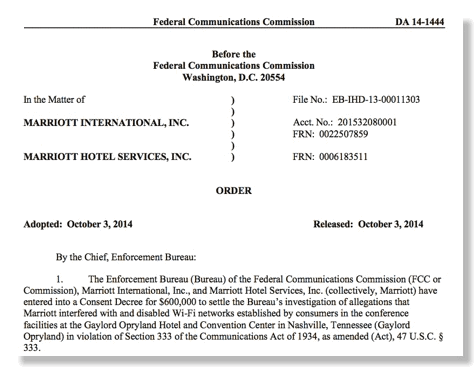
As shown above, FCC released an Order on October 3 terminating an investigation of jamming of Wi-Fi signals at a Marriott hotel by the hotel management with a $600,000 penalty payment. (Until recently such payments were classified by FCC as “voluntary payments” and were tax deductible by the perpetrator - no longer so!)
The press release states
The FCC Enforcement Bureau’s investigation revealed that Marriott employees had used containment features of a Wi-Fi monitoring system at the Gaylord Opryland to prevent individuals from connecting to the Internet via their own personal Wi-Fi networks, while at the same time charging consumers, small businesses, and exhibitors as much as $1,000 per device to access Marriott’s Wi-Fi network.
“Consumers who purchase cellular data plans should be able to use them without fear that their personalInternet connection will be blocked by their hotel or conference center,” said Enforcement Bureau Chief Travis LeBlanc. “It is unacceptable for any hotel to intentionally disable personal hotspots while also charging consumers and small businesses high fees to use the hotel’s own Wi-Fi network. This practice putsconsumers in the untenable position of either paying twice for the same service or forgoing Internet accessaltogether,” he added.
A Washington Post article on the episode was titled “FCC to Marriott: No, you can’t force your customers onto terrible hotel WiFi”. It gives Marriott’s side:
Marriott, in a statement, insisted that its actions were legal and designed to thwart "rogue wireless hotspots.""Like many other institutions and companies in a wide variety of industries, including hospitals and universities, the Gaylord Opryland protected its Wi-Fi network by using FCC-authorized equipment provided by well-known, reputable manufacturers," Marriott said. "We will continue to encourage the FCC to pursue a rulemaking in order to eliminate the ongoing confusion resulting from today's action and to assess the merits of its underlying policy."
Of course, Marriott also sells its own WiFi access for $14.95 a day, sometimes charging for multiple computers in the same room. (It amuses you blogger to observe that cheap hotels such as Quality Inn and Motel 6 generally give free Wi-Fi (often breakfast, too) and charge lower rates than Marriott.
The initial complaint in this case came in March 2013, so the case went from compliant to resolution in 19 months. While this might not seem fast to some, it is much faster than past practice and considering the technical and legal issues involved a timely resolution for string a new precedent a rather timely resolution.
The legal basis for this FCC action was § 333 of the Communications Act , 47 USC 333, a recurring topic here in the context of prison jamming of contraband cellphones. Here is the text of the section:
47 U.S. Code § 333 - Willful or malicious interference
No person shall willfully or maliciously interfere with or cause interference to any radio communications of any station licensed or authorized by or under this chapter or operated by the United States Government.
Clearly Marriott’s action violated this prohibition. While the user’s Wi-Fi system was not “licensed”, it was “authorized” by FCC. Unfortunately, the cellular industry consistently misreads § 333 and tells FCC it means that FCC has no authority to authorize jamming of contraband cellphones in nonfederal prisons, an issue closely related to Docket 13-111.
2014 FCC Excellence in Engineering Award
Janet Young of the Wireless Telecommunications Bureau is the winner of the 2014 Excellence in Engineering Analysis Award. Ms. Young, the sole FCC member of the first Technical Panel created under the Middle Class Tax Relief and Job Creation Act of 2012, provided significant engineering analyses that shortened the transition timelines of Federal incumbents that will relocate or implement sharing arrangements with commercial licensees in two frequency bands that are part of the “AWS-3” spectrum. Her work will allow for faster deployment of new commercial services in this spectrum, which is scheduled for auction November 13, 2014.
Janet Young/WTB
Congratulations to Ms. Young for her achievement and its recognition!
(In previous years there were several awards to individuals as well as a group award, here is an example. This year FCC leadership apparently decided to give one big cash award rather than several small ones. Oddly in the same announcement they gave one award for Excellence in Economic Analysis even though there are a lot more engineers at FCC than economists.)
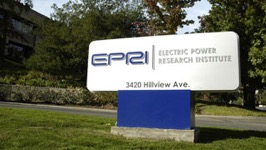
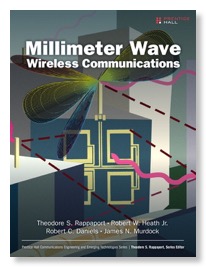


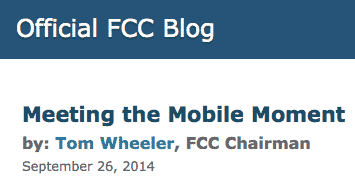






![Validate my RSS feed [Valid RSS]](valid-rss-rogers.png)

